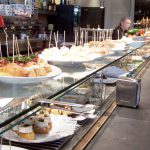Last updated on February 19th, 2020 at 01:36 am.
Jamie Oliver certainly caused a storm when he recommended that paella be made with chorizo. Eduardo Simón from the Customer Care Department at Ábaco explains what should and shouldn’t be in this very important Spanish dish.
What conjures up Spain more than a large, colourful paella? It’s a truly fabulous dish, not only because of its colour and taste but because it is so versatile. It’s also become a little controversial in recent months. Spaniards were reportedly ‘outraged’ by the suggestion that chorizo might be added to a paella recipe. So, to put the matter straight, we’ve done some research into the traditional paella.
The original paella
Paella actually means ‘pan’ in valenciano and this is very much a dish with its roots in Valencia. The nature of its contents would traditionally have depended upon what land workers found on their way to work that day in the Valencian countryside. It’s a seasonal dish but typical ingredients would be butter beans, tomatoes and other, local vegetables with, of course, rice as its basis.
The meat that was used would depend upon what was available. It might be rabbit, chicken or duck and these might have been brought from home by the workers or caught along the way. They would use branches from the pruned orange trees to heat the dish and add rosemary or whatever else was available. A spontaneous way of filling hungry workers.
Of course, if you worked by the sea rather than on the land, the contents could be very different. Fishermen would make their own version replacing meat and vegetables with fish and shellfish.
Paella wasn’t just a source of nutrition. In some respects, it was the centre piece of traditional family life. Everyone had their role in preparing it. Children would run around looking for wood, women would prepare the vegetables and salad and men would stand guard over the fire. Not dissimilar to the traditional barbecue routine in some other countries.
Rules and more rules
The content of the paella might vary according to availability but the process of preparing one was far from random. There are, in fact, many written and unwritten rules surrounding paella preparation. The exact nature of these will depend upon where exactly you come from in Valencia.
For example, which should be added first – the stock or the rice? In Northern Valencia you might find that it’s traditional to boil the stock first and then add the rice. However, in Southern Valencia accepted practice might be for the rice to be fried first and then water added. These might be very specific rules to paella preparation but there are also some more general ones that you might like to implement for yourself:
- Paella must be prepared in a paella, the traditional iron pan, nothing else will do
- The paella should only be around three centimeters deep so that the rice is loose and dry
- The rice should not be moved around or ‘stirred’. Circulating it makes it sticky and more of a risotto
- The contents should be fresh and not processed – so no chorizo
- The paella should be eaten with a spoon and not a knife and fork
Eating your paella
There are not only rules linked to preparing your paella but how you should eat it too. Although paella is often served with lemon it is not traditional to squeeze this over the contents of the pan. The lemon was originally provided to freshen up the fingers and would only be used on the paella if the taste was somewhat lacking.
If there are any vegetables, meat or fish in the paella that you don’t like, don’t scoop them onto your plate with the rest but move them to the centre of the paella where other people can take them instead. In a family-setting it would be usual for everyone to sit around the paella and eat directly from the pan.
Each person has their own section of the dish which they should stick to. Don’t turn round the pan to get to someone else’s portion! The only time you can invade a neighbour’s section of the dish is when they have finished and they indicate this by putting down their spoon.
Now, officially equipped, you should be alert to any signs of paella prepared for tourists and be able to conduct yourself appropriately when in the presence of one of the most vibrant and satisfying dishes on earth.
2 comments
1 March, 2017 2:29 pm
I do agree , and I really do
I do agree , and I really do detest TV “chiefs” that invent traditions and hype up dishes in the never ending quest to be trendy and different. the whole point of traditional food is that it is the same not different !
I remember reading “Cooking on a Small Boat” (Ron Arnold 1966) and he tells of eating, in Jean, Paella with red kidney beans, chopped ham, olives and all manner of things. as well as chorizo.
Having said that I have had a variety of Paellas in Spain and no two were the same.It is still my favourite dish , followed by Sicilian Pizza. I guess Paella is like Flamenco , to the average tourist its just clapping hands and stamping – but to an Andalusian !!
2 March, 2017 8:52 am
Hi Ronaldo
Hi Ronaldo
Even writing this article created a lot of discussion in the office. I will never look at paella in the same way again! Thanks for your comments.






Leave a comment